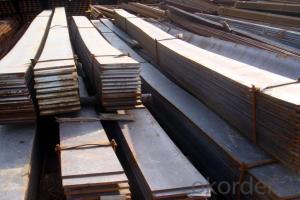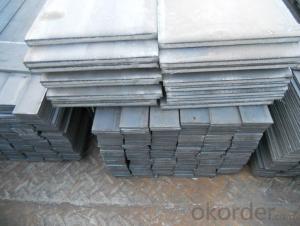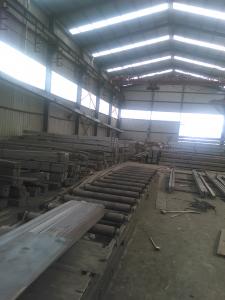Special Steel Flat Bar For Automobile Use
- Loading Port:
- China main port
- Payment Terms:
- TT or LC
- Min Order Qty:
- 50 m.t.
- Supply Capability:
- 5000 m.t./month
OKorder Service Pledge
OKorder Financial Service
You Might Also Like
Commodity: Carbon Steel Flat Bar
Standard: GB, JIS, ASTM,
Material: Q235, SS400 or Equivalent
Origin place: China
Thickness: 3mm-30mm
Width:20mm-200mm
Length: Max 12m
Certification: SGS/BV
Chemical composition
Alloy No | Grade | Element(%) | ||||
C | Mn | S | P | Si | ||
Q235 | B | 0.12—0.20 | 0.3—0.7 | ≤0.045 | ≤0.045 | ≤0.3 |
Physical properties
Alloy No | Grade | Yielding strength point(Mpa) | Tensile strength (Mpa) | Elongation after fracture(%) | ||||||
Thickness (mm) | Thickness (mm) | |||||||||
≤16 | >16--40 | >40--60 | >60--100 | ≤16 | >16--40 | >40--60 | >60--100 | |||
≥ | ≥ | |||||||||
Q235 | B | 235 | 225 | 215 | 205 | 375--500 | 26 | 25 | 24 | 23 |
Usage/Applications of Flat Bar
Widely used for construction;
Machinery manufacturing;
Iron tower steel structure;
Shipbuilding; Steel grating;
Staircase;
Bridge;
Viaduct;
Railway spare parts;
Boilers making etc.
Packaging & Delivery
Packaging Details: The Steel Flat Bars are packed in bundles and loaded in 20 feet/40 feet container, or shipped by bulk cargo ,also we can do as customer's requirements.
Delivery Details:30~45 days upon the receipt of buyer payment by T.T. or L/C.
Production Flow
The Carbon Steel Flat Bar is made through three processes:
1.Feeding the material: Feeding the row material (the steel plate) to Slitting Line.
2.Slitting:The steel plate would be slitted into expected width by lengthways cutter.
3. Leveled and cutting: The plat bar would be ground into level by the grinder and then cut into required length.
FAQ:
Q1: Why buy Materials & Equipment from OKorder.com?
A1: All products offered byOKorder.com are carefully selected from China's most reliable manufacturing enterprises. Through its ISO certifications, OKorder.com adheres to the highest standards and a commitment to supply chain safety and customer satisfaction.
Q3: How soon can we receive the product after purchase?
A3: Within three days of placing an order, we will begin production. The specific shipping date is dependent upon international and government factors, but is typically 7 to 10 workdays.
Q4: What makes stainless steel stainless?
A4: Stainless steel must contain at least 10.5 % chromium. It is this element that reacts with the oxygen in the air to form a complex chrome-oxide surface layer that is invisible but strong enough to prevent further oxygen from "staining" (rusting) the surface. Higher levels of chromium and the addition of other alloying elements such as nickel and molybdenum enhance this surface layer and improve the corrosion resistance of the stainless material.


- Q:Can steel flat bars be painted or coated?
- Yes, steel flat bars can be painted or coated. Steel is a versatile material that can be easily painted or coated to enhance its appearance, protect it from corrosion, or improve its resistance to wear and tear. Painting steel flat bars not only adds aesthetic value but also acts as a protective layer against rust and other environmental factors. Similarly, applying a coating such as powder coating, galvanizing, or electroplating can further enhance the durability and longevity of steel flat bars. These coatings provide additional protection against corrosion and can also offer specific functional properties, such as heat resistance or chemical resistance. Therefore, painting or coating steel flat bars is a common practice to improve their appearance and enhance their performance in various applications.
- Q:What are the safety precautions when working with steel flat bars?
- To ensure a safe working environment and prevent injuries when handling steel flat bars, it is crucial to adhere to specific safety precautions. The following are some key guidelines to consider: 1. Personal Protective Equipment (PPE): It is essential to wear the necessary PPE, including safety goggles, gloves, steel-toed boots, and a hard hat. These items provide protection against potential hazards like flying debris, sharp edges, and falling objects. 2. Proper Lifting Techniques: Since steel flat bars can be heavy, it is important to employ correct lifting techniques to avoid strain or injury. Bend your knees, maintain a straight back, and utilize your leg muscles to lift the bars. If the bars are excessively heavy, seek assistance or employ lifting equipment. 3. Secure Work Area: Organize and maintain a clean work area that is free from obstacles. This minimizes the risk of tripping or falling while handling steel flat bars. Additionally, ensure the floor is dry to prevent slips and falls. 4. Sharp Edges: Exercise caution when handling steel flat bars due to their sharp edges that can cause cuts or punctures. Use appropriate tools and avoid direct contact with the sharp edges. If necessary, wear protective gloves or wrap the edges with duct tape or rubber for injury prevention. 5. Machinery and Tools: When using machinery or tools, always adhere to the manufacturer's instructions and safety guidelines. Verify that the equipment is in good working condition, properly maintained, and suitable for the task at hand. Utilize guards and safety features provided by the equipment whenever possible. 6. Fire Safety: Steel flat bars are highly flammable when exposed to extreme heat or sparks. Hence, it is crucial to have easily accessible fire extinguishers and adhere to proper fire safety protocols in the work area. 7. Training and Knowledge: Ensure that you have received adequate training on handling and working with steel flat bars. Familiarize yourself with the material's properties, potential hazards, and safe working practices. If uncertain about any aspect, consult a knowledgeable supervisor or expert. 8. Communication and Teamwork: If working as part of a team, maintain effective communication with coworkers to ensure awareness of tasks and potential risks. Clear communication helps prevent accidents and fosters a safe working environment. By adhering to these safety precautions, the risks associated with working with steel flat bars can be minimized, leading to a safer and more productive work environment.
- Q:What are the standard tolerances for steel flat bars?
- The standard tolerances for steel flat bars vary depending on the specific manufacturing standards and requirements. However, common tolerances for steel flat bars typically include dimensions such as width, thickness, and length. These tolerances are usually specified in terms of plus or minus a certain amount, such as ±0.005 inches for width and ±0.010 inches for thickness. It is important to consult the relevant industry standards or the specific manufacturer's guidelines to determine the exact tolerances for steel flat bars.
- Q:What are the common finishes for steel flat bars?
- Steel flat bars can be finished in several ways, each serving a specific purpose. The most basic finish is achieved by heating the steel to a high temperature and then rapidly cooling it, resulting in a rough, industrial look with visible mill scale. Another common finish involves passing the steel through rollers at room temperature to achieve a smoother and more refined surface. This is typically used when a more aesthetically pleasing appearance is desired. To protect against corrosion, steel flat bars can be coated with a layer of zinc, acting as a barrier against moisture and other corrosive elements. Alternatively, steel flat bars can be treated with a painted or powder coated finish, providing both protection against corrosion and a wide range of color options. This makes them suitable for various architectural and decorative applications. Lastly, steel flat bars can be polished to achieve a reflective, mirror-like finish. This is often used in decorative applications where a high-end, luxurious appearance is desired. In conclusion, the choice of finish for steel flat bars depends on the intended use and desired aesthetic outcome.
- Q:Building poles, outdoor flat steel, the deeper the buried depth, the better?
- Building poles, outdoor flat steel, buried depth is not as deep as possible. According to the standard requirements, the level of the embedded depth is not less than 0.6 meters.
- Q:Are steel flat bars commonly used in the automotive aftermarket?
- Indeed, steel flat bars find widespread usage within the automotive aftermarket. Their versatility enables a broad spectrum of applications, encompassing fabrication and repairs. Construction or reinforcement of structures, such as roll cages, chassis, and brackets, often relies on the utilization of steel flat bars. The inherent strength and durability they possess render them highly suitable for automotive purposes. Furthermore, steel flat bars can be effortlessly machined, welded, and manipulated to meet precise specifications, rendering them a favored selection among both automotive professionals and enthusiasts alike.
- Q:How do steel flat bars compare to other materials like concrete or glass?
- Steel flat bars have several advantages over other materials like concrete or glass. Firstly, steel flat bars are extremely strong and durable. They have a high tensile strength, which means they can withstand heavy loads and resist deformation. In comparison, concrete is strong in compression but weak in tension, whereas glass is brittle and prone to breaking. Steel flat bars are a much more reliable and long-lasting option when it comes to structural applications. Secondly, steel flat bars offer versatility in terms of design and construction. They can be easily fabricated into various shapes and sizes, making them suitable for a wide range of applications. Concrete, on the other hand, requires complex formwork and curing processes, while glass often has limitations in terms of size and shape. Steel flat bars provide greater flexibility in design and can be easily modified or adjusted if needed. Additionally, steel flat bars have excellent thermal conductivity, which makes them ideal for applications where heat transfer is important. Concrete and glass, on the other hand, have lower thermal conductivity and are not as efficient in transferring heat. This makes steel flat bars a preferred choice for applications such as heat exchangers or structural components in buildings where temperature control is crucial. Moreover, steel flat bars have a higher resistance to fire compared to concrete or glass. They can withstand high temperatures for a longer period without losing their structural integrity. Concrete tends to crack and spall under extreme heat, while glass can shatter or melt. Steel flat bars provide superior fire resistance, making them a safer choice in applications where fire protection is a concern. In conclusion, steel flat bars offer numerous advantages over materials like concrete or glass. They are stronger, more versatile, have better thermal conductivity, and higher resistance to fire. These qualities make steel flat bars a preferred choice for various applications, ranging from structural construction to industrial equipment.
- Q:Can steel flat bars be used for making storage cabinets?
- Yes, steel flat bars can be used for making storage cabinets. Steel flat bars are sturdy and durable, making them suitable for constructing storage cabinets that can withstand heavy loads. They offer excellent structural integrity and can be easily welded or bolted together to create a stable and secure storage solution. Additionally, steel flat bars are resistant to rust and corrosion, ensuring the longevity of the storage cabinets. Therefore, using steel flat bars for making storage cabinets is a practical choice that can provide strength, durability, and a professional appearance.
- Q:Are steel flat bars commonly used in the construction of government buildings?
- Yes, steel flat bars are commonly used in the construction of government buildings. They provide structural support and can be used for various applications such as framing, reinforcement, and the creation of architectural features. Steel flat bars are preferred due to their strength, durability, and versatility, making them an essential component in the construction industry, including government buildings.
- Q:How do you store and transport steel flat bars safely?
- To ensure the safe storage and transportation of steel flat bars, it is essential to follow several important steps: 1. Stack the bars correctly: Proper stacking is crucial in preventing damage. Align each layer of bars horizontally and evenly, distributing the weight evenly across the stack to maintain its structural integrity. 2. Provide adequate support: Prevent sagging or bending of the bars by using sturdy supports such as appropriately sized pallets or racks. Ensure that the supports can handle the weight and size of the bars. 3. Secure the stack: To avoid shifting during transportation, securely fasten the stack with straps or bands. Make sure they are tightly fastened, ensuring that the bars remain in place throughout transit. 4. Take protective measures: Steel flat bars are vulnerable to corrosion, especially when exposed to moisture. Protect them from environmental elements during storage and transportation by using protective covers or wrapping the bars in moisture-resistant materials to prevent rust or damage. 5. Use proper lifting and handling techniques: When moving the bars, employ suitable lifting equipment like forklifts or cranes to prevent accidents or injuries. Ensure that the equipment is capable of handling the weight of the bars and that operators are trained in safe lifting practices. 6. Considerations for long-distance transportation: If transporting the bars over long distances, it may be necessary to utilize specialized shipping containers or trucks equipped to handle heavy loads and provide adequate protection from external elements. By adhering to these guidelines, you can minimize the risk of damage, accidents, and corrosion, ensuring the safe delivery of steel flat bars to their intended destination.
1. Manufacturer Overview |
|
|---|---|
| Location | |
| Year Established | |
| Annual Output Value | |
| Main Markets | |
| Company Certifications | |
2. Manufacturer Certificates |
|
|---|---|
| a) Certification Name | |
| Range | |
| Reference | |
| Validity Period | |
3. Manufacturer Capability |
|
|---|---|
| a)Trade Capacity | |
| Nearest Port | |
| Export Percentage | |
| No.of Employees in Trade Department | |
| Language Spoken: | |
| b)Factory Information | |
| Factory Size: | |
| No. of Production Lines | |
| Contract Manufacturing | |
| Product Price Range | |
Send your message to us
Special Steel Flat Bar For Automobile Use
- Loading Port:
- China main port
- Payment Terms:
- TT or LC
- Min Order Qty:
- 50 m.t.
- Supply Capability:
- 5000 m.t./month
OKorder Service Pledge
OKorder Financial Service
Similar products
New products
Hot products
Related keywords


























